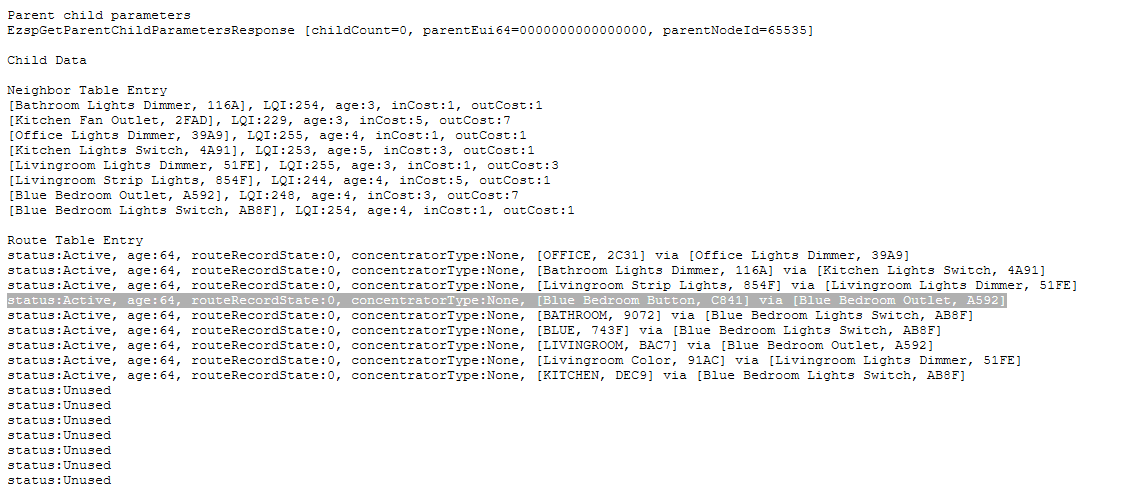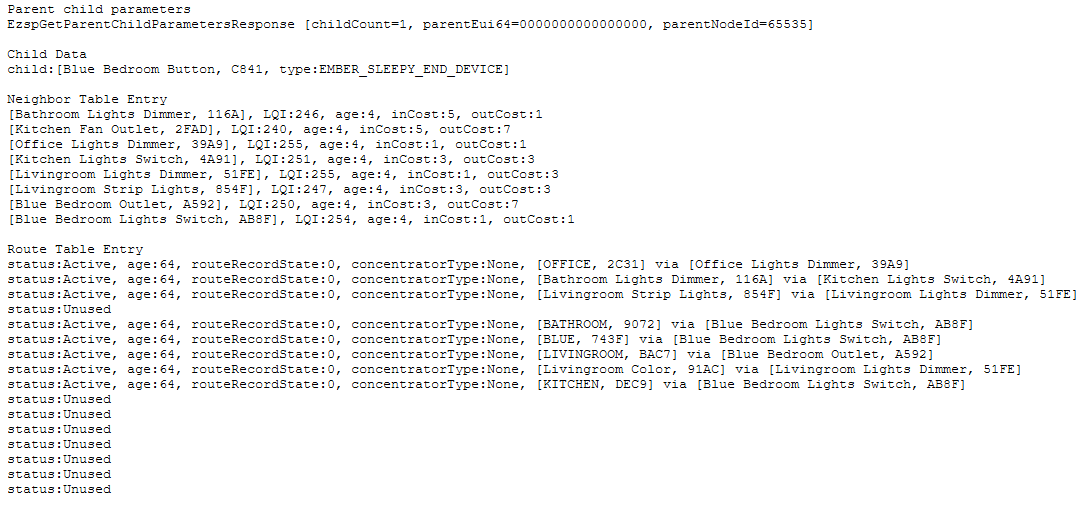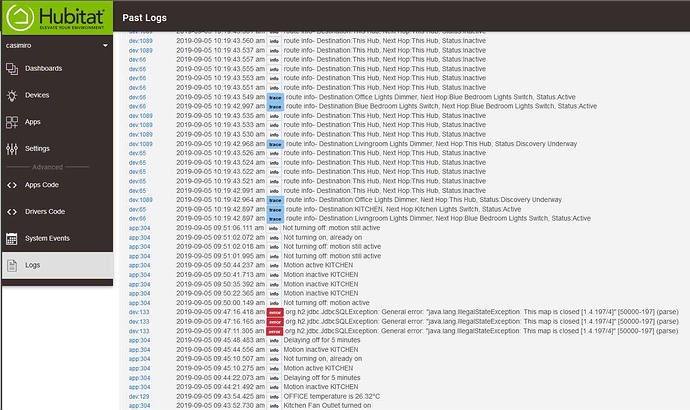Thanks.
This will be very helpful as I build out my new Hubitat network.
....Even better has Mac support.
I am starting to think I may have a bum hub. Despite removing all user apps I crashed again when temp sensors in my room were reading 78.
@mike.maxwell @bravenel how do we go about getting a warranty replacement?
@zarthan I have used your url and I am assuming that the Route Table Entry are the actual repeaters? So if a device is in the Child Data but isn't showing up in the Route Table then it is not considered a repeater? thanks
I also noticed something else strange. I have 4 zigbee power switches downstairs and they are all the same type and part number yet only one of them shows up in the Route Table.
I now have another question about the zigbee url that gives you a list of child devices and routers.
I removed one of the eria bulbs and replaced it with a sengled bulb. The eria bulb is still in the list of devices I am just temporarily testing the sengled in it's place.
I included the sengled bulb ok. I go to the url provided by @zarthan and it shows the eria bulb still in the list of devices even though it is not even in a light socket!
Then I notice that the sengled bulb doesn't even show up at all even in the child devices!
Anyone know what is going on and why? thanks
Reboot the hub and it will go away
Ok, I will try that. Thanks
After rebooting hub the eria bulbs come in as a repeater, I assume, since they are listed in the Route Table.
status:Active, age:0, routeRecordState:0, concentratorType:None, [LR South Light, 90E9] via [LR South Light, 90E9]
Also the sengled bulb does not show up even in the Child Data List.
I’m guessing that the devices connected to the hub don’t show up there.
@razorwing I don't have a great understanding of everything in that list. I don't know how often the list is recalculated or rebuilt. Some devices I have, don't show up in the list but are fully functional?????
Some numbers are of worth keeping an eye on. The LQI or Link Quality Index. Closer to 255 is good.InCost and OutCost refer to aging in neighbor tables. Not easy to understand.
I basically use the list to get some idea of where things stand and combined with the ZigBee logs it somewhat helps. I don't think it is a complete picture. I think @mike.maxwell would be the person to really fill in the blanks of which there are many.
Side note, it would be nice if that page "always" worked... It is very intermittent on my hub. Sometimes it works, sometimes it doesn't...
I make my own zigbee module. From time to time, I have to read up on the neighbor and routing table in my quest. Here is what my understanding about them. I hope it help.
Neighbor table is a list of devices that your devices ever come in contact. A device may received packet from other devices in form of unicast or multicast. A device should keep this table updated as a packet received. This table is useful for a device to optimize during packet transmission. When a packet is send from higher level of the stack arrived, your device will look at this table and see if they are within range based on this table. If yes, it will send the packet directly.
A routing table is a table that a device keep a cache of a known route to another device in the mesh. When a zigbee device need to send packet to another device where it is not in the neighbor table, it will have to issue a command to do route discovery. Once discovered, the device will record this on the routing table. This table should get updated if a routing to a device is issued and a successful respond is received.
I am not sure if these tables are refreshed/rebuilt per say. They are just get updated as needed. Just FYI, the table's entries count is typically limited. I would not be surprised not seeing your expected devices in the table. In large mesh, when the table is full and a new entry need to be added, another one will be purge out. I am not 100% sure if they are first in first out or some other method.
These information is a great help to troubleshoot your issue. However, it is just a small part of Zigbee. There are plenty of other area where things can go wrong.
Since I put in an ST outlet I've been having devices drop off the network.
Anyone else using the ST outlet as a repeater?
Also I just cannot get the zigbee table to load anymore.
Anybody have any ideas what it could be.
Here is my url info.
http://192.168.0.24/hub/zigbee/getChildAndRouteInfo
This is what I get. (With more info left out).
<!doctype html>
Error 500 @font-face { font-family: 'Material Icons'; font-style: normal; font-weight: 400; src: url(/ui2/css/fonts/MaterialIcons-Regular.eot); /* For IE6-8 */ src: local('Material Icons'), local('MaterialIcons-Regular'), url(/ui2/css/fonts/MaterialIcons-Regular.woff2) format('woff2'), url(/ui2/css/fonts/MaterialIcons-Regular.woff) format('woff'), url(/ui2/css/fonts/MaterialIcons-Regular.ttf) format('truetype'); font-display:block; } @font-face { font-family: 'hubitat'; src: url('/ui2/css/fonts/hubitat.eot?roox2j'); src: url('/ui2/css/fonts/hubitat.eot?roox2j#iefix') format('embedded-opentype'), url('/ui2/css/fonts/hubitat.woff2?roox2j') format('woff2'), url('/ui2/css/fonts/hubitat.ttf?roox2j') format('truetype'), url('/ui2/css/fonts/hubitat.woff?roox2j') format('woff'), url('/ui2/css/fonts/hubitat.svg?roox2j#hubitat') format('svg'); font-weight: normal; font-style: normal; TIA.I’m using 2 of the last gen SmartThings outlets and 1 of the current gen. I haven’t had anything but improvement in the mesh since adding them. I did unplug the hub for 20 minutes shortly after joining the outlets to speed up the mesh reconfiguration.
Just thought I would update where I am with the zigbee issues I've been having.
Removed my ST outlet and then shut down the hub for 30 minutes.
All my zigbee devices came back on line OK.
I have not had anything drop off the network for 2 days now.
From my point of view the ST outlet is NOT a good repeater and will now be consigned to my garage Christmas lights.
EDIT:BTW the zigbee route info script now works again. Spooky.
Today when I wake up my whole zigbee network was down and I realize of that because of this same message on my hub "zigbee network offline".
My Hub is a very clear place so I guess this do not happend due heat, so following the logic I faced a flood of my network? I do not have too many devices and this never happened before.
Which are the cause of this?
How can be avoided?
Some more questions:
I made a test today and I removed the battery of my "Blue Bedroom Button" but in the Table Route still the same info even when I refresh the browser several times......
but after restore the battery after some minutes I realize this entrance was removed from my table route so.. the info showed in that tabel has some delay right?.
- Do any of you know how many minutes of delay the table route have?
- If where is saying [DeviceX] via [Device Y] means the [DeviceX] is connecting throught the [DeviceY] then I realize some devices are not connected to the nearest repeaters. Is there a way to adjust this or they connect to the better one?
- The "age" is the signal strenght of each devide?
I'm not sure how often the route table info is updated for display purposes in the log, but for the Ember Zigbee stack, the 'age' count represents the number of 16 second intervals that have elapsed since the last link status message was received (a Zigbee router usually sends a link status message every 16 seconds; when the neighbor table entry's age count becomes greater than 6, this neighbor entry is considered 'stale' and is eligible to be 'evicted' from the table and its 'cost' gets set to zero, indicating 'unknown').
The end devices choose their 'best' parent router based on their assessment of the link (which may not be the closest, physically). You don't normally have a way to control this process.
Wow amazing explanation..... I got it Tony thanks!!
So there is no strength signal report here right?
... is there any other screen where I can see where is better to set physically a device?
The LQI figure can indicate signal strength/integrity of the link as a whole (in some implementations it takes into account the link error rate); numbers approaching 255 are better (basically if it is >200 it should be acceptable).
If you want to see the 'last hop' received signal strength metric (RSSI) from a device (keep in mind if an end device is not a child of the hub, you will be seeing the RSSI of the last router in the path's transmitter, not the end device's-- that's what the 'last hop' means), go to Settings > Zigbee Details > Zigbee Logging. But note that RSSI is a 'raw' measure of the RF energy and can include other networks in the same frequency band, as well as noise.
The more negative the RSSI number, the lower the measured signal strength. Most of my devices very close to the hub show RSSI's in the -40's / -50's or so; I don't have any apparent issues even when they are in the -80s although I'm sure some retries may be happening. When the RSSI gets to the -90's though, the signal is getting down to the noise level.
Hi guys
Today I faced another issue here.... My wife waked up first and she told me everything was ok with my HE (lights turning on automatically, etc...), but when I waked up nothing was wortking and I couldn't login in HE as the web interface never shows up. I checked and the hub was connected to my intranet (ping was ok).
So I checked Past Logs and I found this:
dev133 is a Generic Zigbee Motion Sensor on my kitchen (a samsung motion sensor)
I never saw that error before and after that nothing was working.... I have to remove the power manually and plug it again. Now all is ok.
What was that?
Why happened?
Don't want this happen when I be outside my home.... so how to avoid it?




